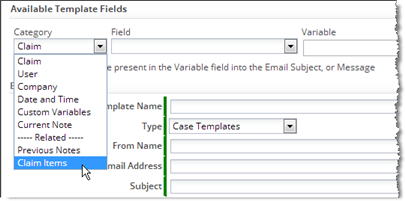Difference between revisions of "Create a PowerPoint Document Template"
imported>Aeric |
imported>Aeric |
||
| Line 24: | Line 24: | ||
===Convert Currency Variables to Numbers=== | ===Convert Currency Variables to Numbers=== | ||
{{:Common:Convert Variables to Numbers}} | {{:Common:Convert Variables to Numbers}} | ||
==Processing Related Records== | |||
{{:Common:Processing Related Records in MS Office}} | |||
==Inserting an Image Stored in an Object Record== | ==Inserting an Image Stored in an Object Record== | ||
Revision as of 21:52, 26 July 2013
A PowerPoint file can also be used as a document template.
- Learn more: Document Templates
Creating the Template File
- On your local system, create a PowerPoint presentation.
- Add boilerplate text and fixed graphics.
- Add placeholder images for any record images or charts you plan to add. Size them appropriately.
- Insert template variables, record-specific images, and/or charts, as explained below.
- Saved it in .pptx format.
Working with Template Variables
Inserting Template Variables
- Begin to Add a Document Template or [Edit] an existing template.
The Template Variable Tool appears. - Select the Category of fields to choose from.
(Fields in the current object or Related Objects, User fields, or Company fields) - Under Fields, scroll down the list to find fields in the current record or in a Lookup target record.
- Select the field to add.
The variable name appears. - Copy the variable name to the clipboard.
- In the template file, paste the variable name you copied.
Convert Currency Variables to Numbers
When you want to do calculations on a currency field in Velocity, you need to create a number from the currency strings delivered by the platform. That string has the form $24.95. The following code converts it to a number that can be used in calculations:
- <syntaxhighlight lang="html4strict" enclose="div">
- set($n = 0.00)
- set($s = $YourObject.currency_field.substring(2) )
- set($n = $n.parseDouble($s)
</syntaxhighlight> where:
- $n = 0.00 creates an instance of the double-precision float class (Double)
- $YourObject.currency_field.substring(2) removes the first two characters from the currency string. (The $ sign and the space that follows it.)
- parseDouble($s) converts the resulting string into a double-precision float--a number that can be used in calculations.
Processing Related Records
Finding Related-Record Variables
Related Object variables are found using the Template Variable Tool.
Here, in the Email Template for Claims, the related ClaimItems object is being chosen from the category list:
Within that group, the Item Name field is listed, along with other fields in the ClaimITems object. Once selected, the variable name appears in the Variable area, along with the loop it needs to be surrounded by for processing:
- #foreach( $ClaimItems_record in $ClaimItems ) $ClaimItems_record.item_name #end
If a loop already exists, you would use only the variable name part:
- $ClaimItems_record.item_name
Note:
For a many-to-many relationship like one between Claims and Tags, the variable looks like this:- $Claims_Tags_record.related_to_Tags.tag_name
where:
- $Claims_Tags is the Junction Object that produces the many-to-many relationship
- related_to_Tags is the name of the Lookup field in the Junction Object that references a Tags record
- tag_name is the field to display
- The "dot" separator (.) joins each of the segments in the variable name
Using Related-Record Variables
For HTML, you insert related records into a table by putting loop-controls around code that specifies the format for a row:
- #foreach($i in $Order_Items)
- <tr>...row contents here...</tr>
- #end
The problem in MS Office tables is that there is no place "outside the row" to put those loop controls.
The solution is to use two special constructs that go into the first cell of the row:
- @before-row#foreach($i in $Order_Items)
- @after-row#end
- Considerations
-
- The constructs only need to be specified once in the row, in the first cell.
- Between them, include the field that will be displayed in the cell
- Like the fields, the loop construct are inserted into the cell as fields
- Insert > Quick Parts > Field, Category: Mail Merge, Field type: MergeField
- Or copy an existing field, right click, and select the Edit Field... option
- For other cells in the row, specify the field to include in that cell, without the extra constructs
- Example
- Cell 1:
- «@before-row#foreach($i in $Order_Items)»
«$i.item»
«@after-row#end»
- «@before-row#foreach($i in $Order_Items)»
- Cell 2:
- «$i.quantity»
- and so on...
- The resulting table will look something like this (with line breaks included in the first cell to make it more readable):
- Sample Template: OrderInvoiceWordTemplate.docx
- Learn more: Solution: use @before-row @after-row
Inserting an Image Stored in an Object Record
To insert an image:
- Select a placeholder image to replace.
- Right click on the image. Choose Size and Position...
- Click the Alt Text tab
- In the Alternative Text area, type in a platform IMG tag
- IMG Tag
- IMG{$objectName.imageFieldName}
where:
- objectName - The name of the current object. (This variable is in Velocity format. The object name effectively creates a namespace, ensuring that there is no conflict with another variable that might have the same name.)
- imageFieldName - The name of the field in the current record that contains the image to display, joined to the object name by a "dot" (.).
- Result
- The URL for the image is inserted into the generated page. When viewed, the image is displayed.
- Example
- IMG{$Customer.logo_image}


